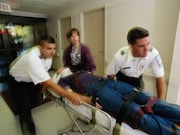
WEDNESDAY, Dec. 19, 2018 — Car crashes and guns have been the two leading killers of kids in the United States for decades, and deaths from both causes are on the rise.
More children have been dying from motor vehicle crashes and firearms injuries since 2013, a new report shows.
Car crashes accounted for 20 percent of all deaths for children aged 19 and younger in 2016, while firearms accounted for 15 percent of these deaths, the researchers said.
By comparison, cancer was responsible for about 9 percent of childhood deaths that year, said lead researcher Dr. Rebecca Cunningham, director of the Injury Prevention Center at the University of Michigan.
“I think most people don’t realize firearms are killing substantially more children than cancer,” Cunningham said. “I think that’s pretty new news to most Americans.”
The recent uptick in deaths from cars and guns represents a reversal of all-time lows in 2013, according to the new report.
But while substantial progress has been made since 2000 in reducing the rate of child deaths caused by car crashes, the rate of firearms deaths remains about where it was at the dawn of the century.
“We’ve made tremendous strides in motor vehicle crashes, whereas with firearm injuries, we’ve made no progress at all,” Cunningham said.
The rate of child deaths in motor vehicle crashes has been cut in half, from around 10 deaths per 100,000 children in 1999 down to 5.2 deaths per 100,000 in 2016, the findings showed.
“We’ve had tremendous public health success for reducing motor vehicle crash deaths,” Cunningham said. “We’ve halved the rate in the past 17 years.”
Crash deaths had been even lower, around 4.5 per 100,000 in 2013, but there’s been a recent uptick, the investigators found.
Researchers aren’t sure what’s behind the recent increase in traffic crash deaths, but they think distracted driving and marijuana legalization might have contributed to it.
“Before 2013, most teenagers didn’t have cellphones while they were driving, probably,” Cunningham said. “There are some things that are different that need a lot more looking into.”
There’s also been an uptick in firearms deaths among children, but there’s been much less progress made there.
Firearms deaths among children in 2016 occurred at a rate of about 4 per 100,000, up from 3.1 per 100,000 in 2013. That’s a relative increase of 28 percent, the researchers noted.
But it’s not much different from 1999, when the rate hovered just under 4.5 firearms deaths per 100,000 children, or the 2007 rate of 3.9 deaths per 100,000.
Between 2013 and 2016, gun-related homicides among children rose 32 percent, and gun-related suicides increased by 26 percent, according to the report.
“We see more suicide in rural areas and more homicide in urban areas, but nonetheless, firearms are a safety problem for children across all neighborhoods. They’re in everyone’s back yard,” Cunningham said.
The difference in progress can be chalked up to the interest, emphasis and money that the public has placed on motor vehicle deaths versus firearms deaths, she added.
“We’ve invested a lot of money in traffic safety research. There’s been a lot of investment in counseling families and teens around driving more safely. We’ve invested a lot in safer vehicles. We’ve invested a lot in safer roads. We’ve spent a lot of money on research to see which of those factors matter. We’ve invested as a country tremendously. We do not want these many people dying on the roads, and we’ve changed that,” Cunningham said.
“The message around firearm injury is we haven’t invested at all. As a country, we’ve invested really not at all in firearm-related research, in doing any of the public health and injury prevention science we know could contribute to a decrease,” she continued.
“We’ve seen tremendous decreases in all other types of injury when we’ve applied research to them,” Cunningham explained. “We haven’t done that with firearms, and because we haven’t done that, we have pretty much a flat line, with the bump of the last couple of years even going in the wrong direction.”
The report by Cunningham and her colleagues was published in the Dec. 20 issue of the New England Journal of Medicine.
According to Dr. Robert Glatter, an emergency physician with Lenox Hill Hospital in New York City, the United States can halt these reversals through “common sense and practical behaviors that can save our children’s lives.”
These include “eliminating distractions, such as texting while driving, and getting more sleep to reduce driver fatigue and drowsiness,” Glatter said. “When it comes to gun safety, proper storage of guns along with novel biometrics to keep triggers locked could also be lifesaving.”
Of the 20,360 deaths among U.S. children and teenagers that occurred in 2016, injuries caused more than 60 percent, Cunningham’s team found.
Rural kids were most at risk with 33 deaths per 100,000, compared with 27 per 100,000 for suburban kids, and 23 per 100,000 for urban children, the study authors said.
That’s mainly due to higher injury-related deaths in rural settings. For example, rural children and teens died 2.7 times more frequently in motor vehicle crashes. One factor in these deaths could be longer emergency medical service response times.
“The bottom line is that we need to be proactive by focusing on research related to injury prevention, as opposed to being reactive once tragic events occur,” Glatter said. “We owe it to our children and future generations.”
More information
The U.S. Centers for Disease Control and Prevention has more about preventing childhood injuries.

© 2018 HealthDay. All rights reserved.
Posted: December 2018
